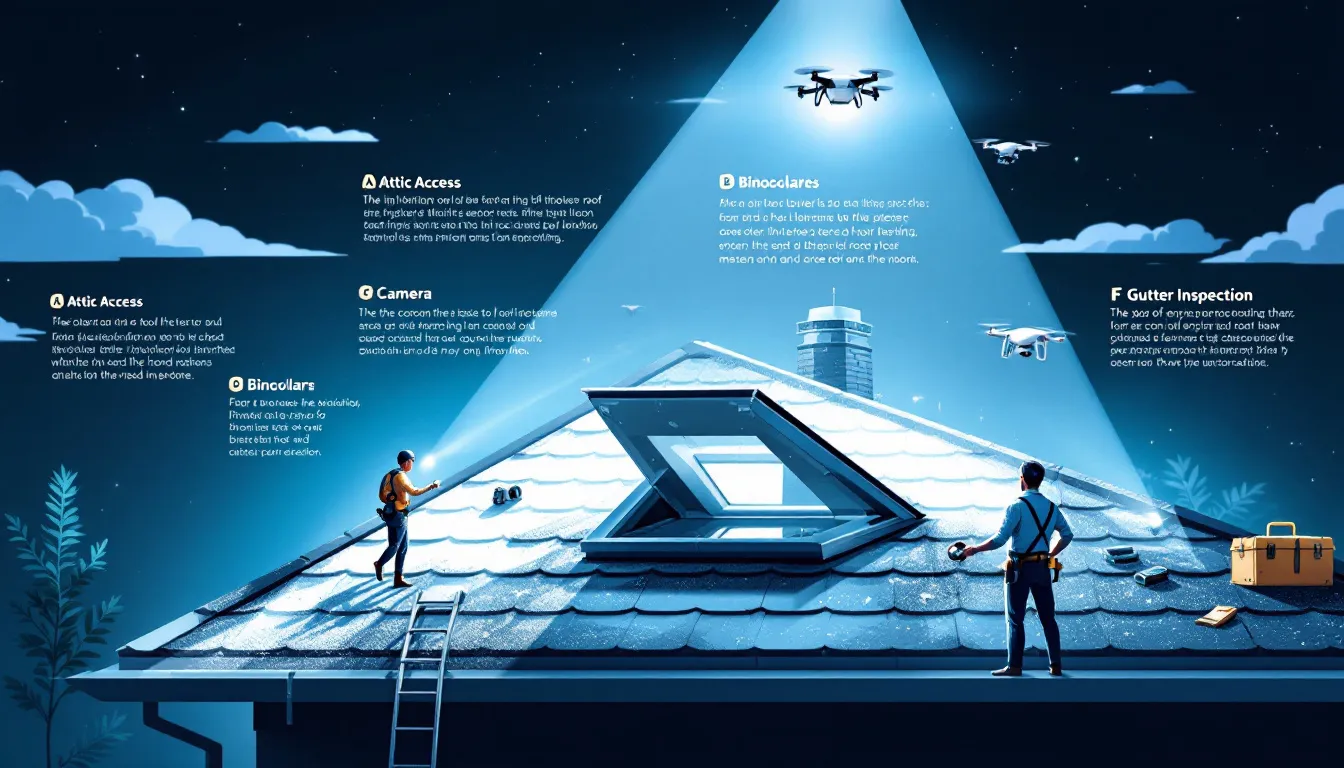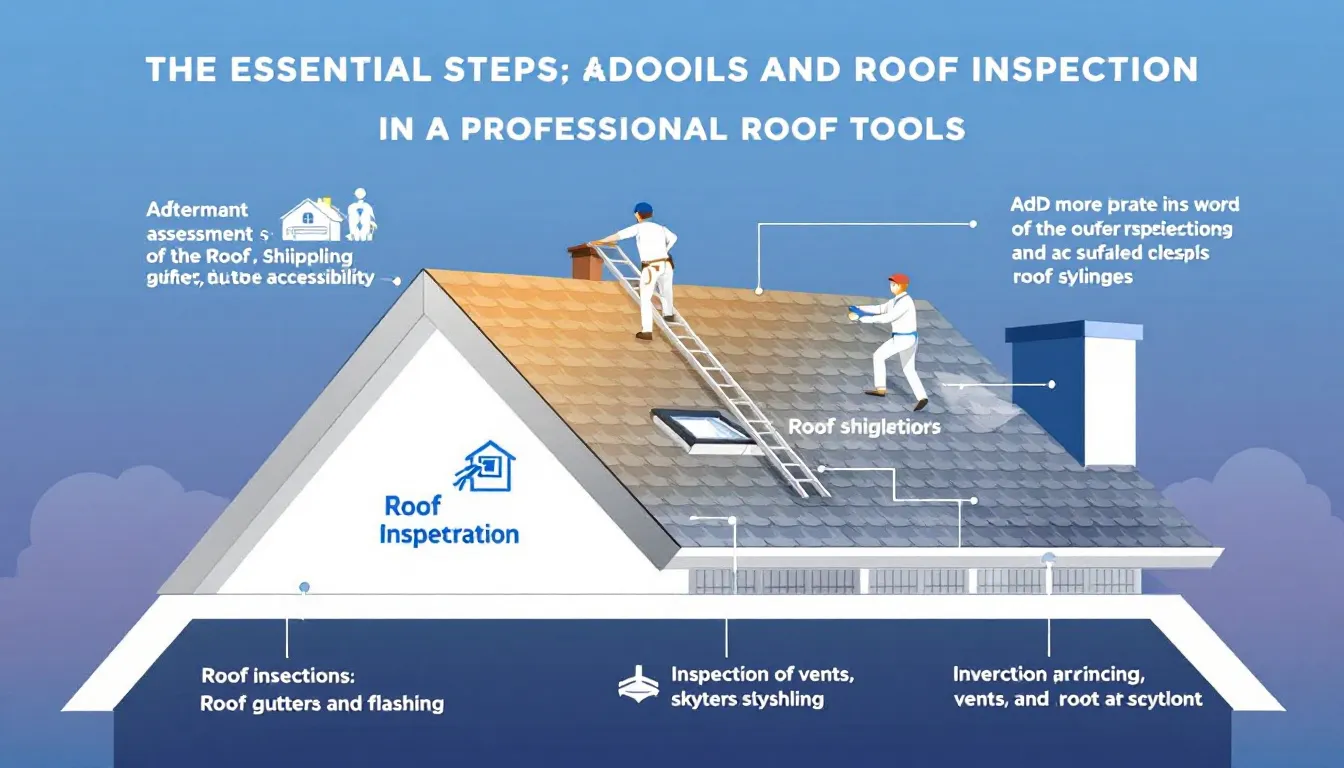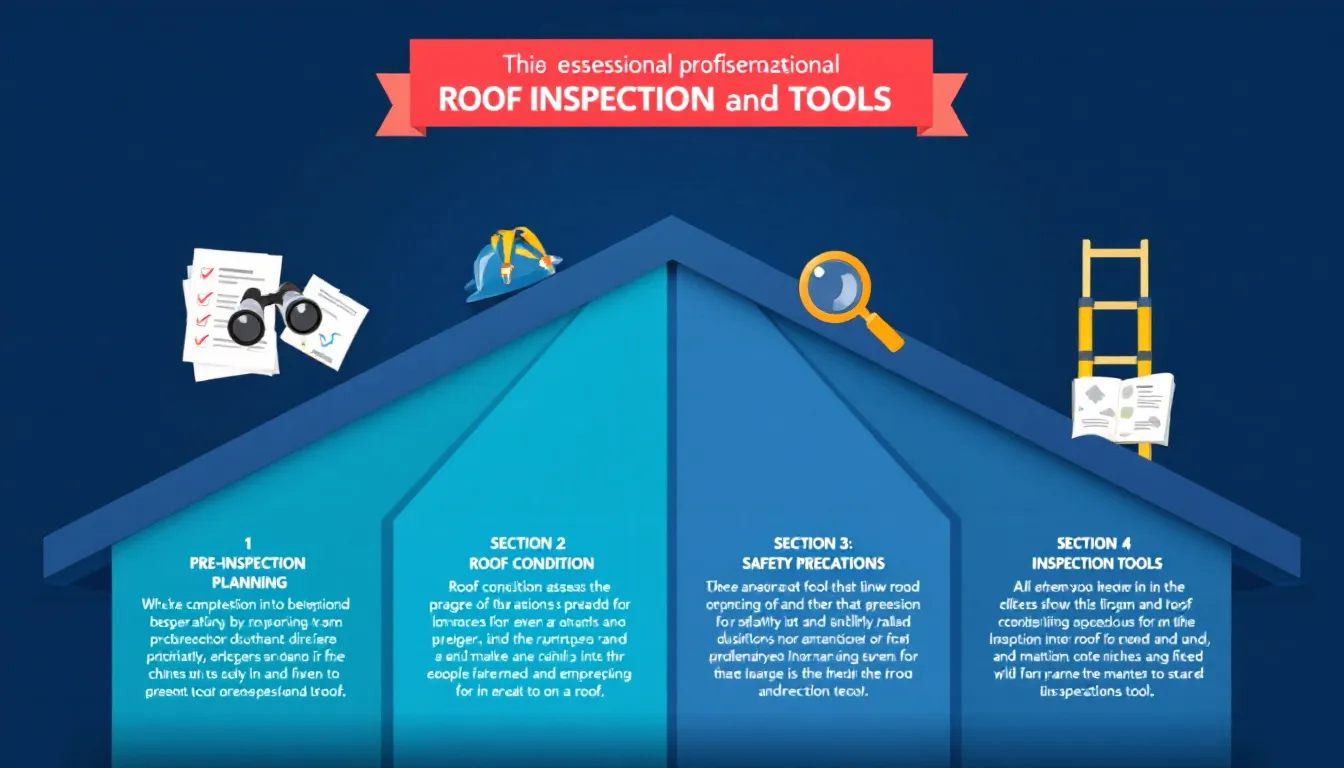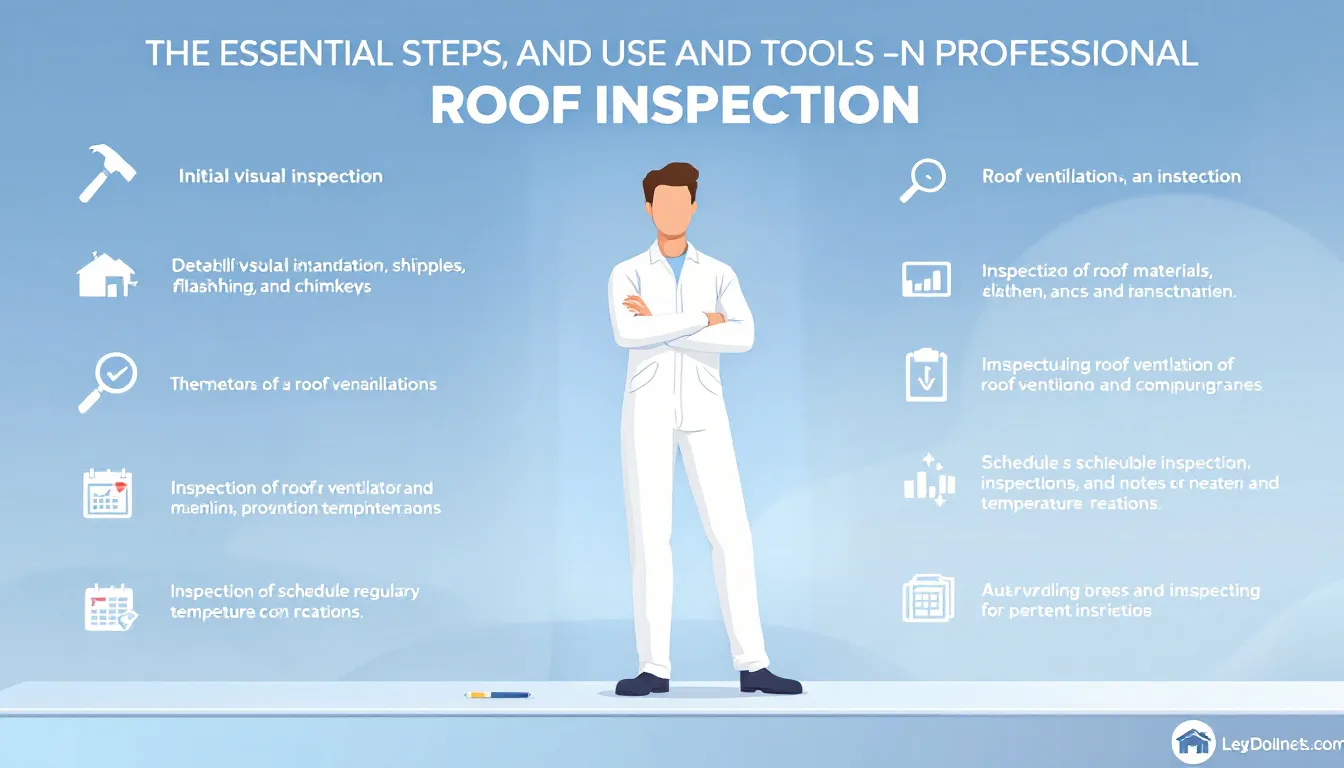Are you worried about the condition of your roof? Roof inspections can uncover hidden issues and save you from expensive repairs. In this guide, we’ll explain what roof inspections involve, when to schedule them, and what components are checked. Stay with us to ensure your roof stays in top shape.
Key Takeaways
- Regular roof inspections are essential for identifying minor issues before they escalate, ensuring a roof’s longevity and functionality.
- Key components evaluated during a roof inspection include roofing materials, structural integrity, roof penetrations, and the gutter system.
- Professional roof inspectors should be certified, and homeowners must inquire about their experience and qualifications before hiring.
Understanding Roof Inspections

Roof inspections are more than a cursory glance at your roof; they are a detailed evaluation of your roofing system’s health and functionality. A roof inspector, unlike a home inspector, focuses solely on the roof, ensuring that every part is meticulously checked for any signs of damage or wear. Regular roof inspections certify a roof’s quality and expected lifespan, offering homeowners peace of mind.
A thorough roof inspection answers all pertinent roof inspection questions, addressing both visible and hidden damages. We will delve into the definition of a roof inspection and the importance of regular checks for a healthy roofing system.
Definition of Roof Inspection
A roof inspection is a thorough examination of all roofing components, aimed at providing a detailed analysis of the roof’s condition. Conducted by certified roofing professionals, these inspections cover both visible and hidden damages, assessing the roof’s overall health. This comprehensive evaluation includes checking the roof from the outside, accessing the attic, and even inspecting the garage if applicable.
Understanding the materials used allows inspectors to provide insights into the roof’s condition and maintenance requirements.
Importance of Regular Roof Inspections
Preventing costly repairs requires regular roof inspections to identify minor issues before they escalate. Proactively addressing roofing problems can lead to significant savings on repairs in the long run. Homeowners should especially consider a roof inspection if their roof is over five years old and has not been inspected within the past year.
Inspecting vulnerable roof areas regularly helps catch potential issues early, ensuring longevity and functionality.
Key Components Checked During a Roof Inspection

During a roof inspection, various components of the roof are evaluated to ensure the structural support and stability of the roofing materials. A roof inspector examines specific components, including fascia, soffits, and signs of leaks in the attic and interior spaces. These inspections are crucial for identifying any problems and recommending solutions to maintain the roof’s integrity.
We will discuss key components checked during a roof inspection, including roofing materials, structural integrity, roof penetrations, gutter system, and attic and interior inspection as part of the roof system. Each of these components plays a crucial role in the overall health of your roof and needs to be thoroughly checked.
Roofing Materials
Inspectors look at the condition of shingles, metal plates, clay, and slate during a roof inspection. They check for damages, missing materials, and staining from rust, moss, or water damage. Closely examining these materials helps inspectors identify signs of damage, wear, or aging. Potential weak spots for leaks, such as roof valleys, are also scrutinized.
Homeowners are advised to inspect their roofs after hail or snowstorms to spot unseen damages early.
Structural Integrity
Inspectors assess the condition of the roof’s decking, checking for signs of sagging or softness. They examine the structural stability of the roof by looking for weak spots, sagging, and rot in the wooden decking. Rafters and joists are checked for cracking, splintering, and adequate support, as these components are essential for the roof’s structural integrity.
Resolving issues found during this inspection is vital for maintaining roof stability.
Roof Penetrations
Roof penetrations such as skylights, chimneys, and vent pipes are meticulously inspected. Inspectors evaluate the condition of these penetrations, including the grout, seals, and exterior condition. They check for rust or cracks in metal flashing and examine the sealing elements to ensure they are intact.
Regular checks of these features can prevent leaks and other issues.
Gutter System
Inspecting the gutter system is vital to ensure it is free from blockages and functioning correctly. Inspectors confirm that gutters are not holding standing water and that downspouts are firmly attached for proper drainage.
During the inspection, they look for blockages, cracks, broken seams, shingle granules, and aggregate materials.
Attic and Interior Inspection
Before: Inspectors check the roof structure’s underside, including rafters, joists, and decking, for mold, pest infestations, water stains, and signs of leaks. Identifying these issues early can lead to timely repairs, preventing costly damage in the future.
After: Inspectors check the roof structure’s underside for:
- Mold
- Pest infestations
- Water stains
- Signs of leaks
Identifying these issues early can lead to timely repairs, preventing costly damage in the future.
Inspecting the attic and interior spaces helps spot leaks, mold, and water damage indicating roof problems.
When to Schedule a Roof Inspection
Timing is everything when it comes to roof inspections. Scheduling inspections at the right time can help maintain the roof’s integrity and prevent future problems. Different scenarios call for roof inspections, such as seasonal changes, after severe weather events, and before major home transactions.
We will explore the best times to schedule a roof inspection, including seasonal considerations, after severe weather events, and before buying or selling a home.
Seasonal Considerations
Spring and fall are ideal times for scheduling roof inspections. Inspections in the fall allow for repairs before winter weather sets in.
Spring inspections take advantage of mild weather and provide an opportunity to address any winter damage.
After Severe Weather Events
Homeowners should schedule a roof inspection after severe weather events like hurricanes or tornadoes to assess potential damage. An insurance company may cover the costs of these inspections, making it an opportune time to ensure the roof is in good condition.
Post-storm inspections can identify damage and provide quotes for necessary repairs or replacements.
Before Major Home Transactions
Regular inspections are recommended after five years to ensure the roof’s condition is documented before major home transactions. Consulting a realtor or bank can help find a qualified roof inspector to provide accurate documentation of the roof’s condition, aiding in real estate negotiations.
Cost of Roof Inspections

Understanding the cost of roof inspections is crucial for budgeting and planning. The roof inspection cost can vary depending on factors like location, access, and the type of inspection required.
We will provide an overview of the average cost range and discuss advanced inspection methods.
Advanced Inspection Methods
Advanced roof inspection methods, such as infrared inspections, typically cost more due to the specialized equipment and expertise required. An infrared roof inspection typically costs between $400 and $600. This average cost varies depending on specific factors.
These methods, including the use of drones and thermal cameras, provide detailed assessments and can cost between $500 and $600.
Hiring a Professional Roof Inspector

Engaging a professional inspector roof inspector ensures a thorough evaluation of your roof’s condition.
We will discuss how to evaluate the qualifications of a roof inspector and key questions to ask before hiring one.
Evaluating Qualifications
Engaging a certified roof inspector ensures a thorough evaluation of the roof’s safety and integrity. It’s vital to hire someone with proven expertise in roofing, as experience in the construction or roofing sector is beneficial for a roof inspector’s qualifications.
Each state has different licensing requirements, so verify local regulations and check for relevant certifications and training in roof inspection practices.
Questions to Ask
When interviewing prospective roof inspectors, ask about their experience with the specific type of roofing system you have. Request references from previous clients to gauge their reliability and quality of service. Confirm whether all workers are certified and trained to ensure safety and liability coverage during inspections.
Asking about past projects can help you assess their experience and reliability.
The Roof Inspection Process
The roof inspection process involves several steps to ensure a comprehensive evaluation. We will cover preparation, the inspection procedure, and the post-inspection report.
Preparation
Preparation involves cleaning organic debris from the roof at least twice a year to prevent moisture buildup and shingle damage. Trimming tree branches to prevent them from scratching the roof surface during storms is also essential.
Regular gutter cleaning prevents water accumulation, which can lead to roof damage.
Inspection Procedure
A standard roof inspection involves both a simple visual inspection and the use of tools to identify potential issues. Inspectors often climb onto the roof and rely on visual checks, focusing on the condition of roof flashings, which are crucial for preventing water intrusion.
The use of technology such as drones and infrared cameras is becoming increasingly common for detailed roof inspections.
Post-Inspection Report
After completing an inspection, a roof inspector provides a written report detailing every aspect of the inspection. This official report is essential for documenting the roof’s condition before selling or refinancing a property.
A thorough roof inspection is highlighted by detailed reporting of every aspect of the ultimate roof inspection guide.
Maintaining Your Roof Between Inspections

Maintaining your roof between inspections can significantly extend its lifespan and prevent premature replacements.
We will discuss regular cleaning and addressing minor repairs.
Regular Cleaning
Regular cleaning of your roof and gutters is crucial for preventing debris accumulation and potential water damage. Cleaning prevents issues such as clogged gutters, which can lead to water backup and leaks into the home.
Following a regular cleaning schedule can significantly prolong the lifespan of your roof and reduce repair costs. Request recommendations from your inspector for maintenance routines to keep your roof in good shape.
Addressing Minor Repairs
Promptly fixing small leaks or damage can prevent them from escalating into major issues. Addressing small issues like loose flashing or damaged seals can prevent larger problems down the line. Regular roof inspections help identify these minor problems early, ensuring that they are addressed before significant damage occurs.
Summary
In summary, roof inspections are an essential part of home maintenance, ensuring the longevity and safety of your roofing system. Regular inspections help identify minor issues before they become major problems, saving homeowners significant costs in the long run. By understanding the key components checked during an inspection, the optimal times for scheduling, and the costs involved, you can better prepare for and maintain your roof.
Remember, hiring a qualified professional inspector is crucial for a thorough evaluation. Ask the right questions and check their credentials to ensure you are getting the best service. Maintaining your roof between inspections with regular cleaning and prompt repairs will help keep your roof in top condition, providing peace of mind and protection for your home for years to come.
Frequently Asked Questions
What is a roof inspection?
A roof inspection is a comprehensive evaluation of all roofing elements to assess their condition and identify any necessary repairs. This analysis is crucial for maintaining the integrity and longevity of your roof.
Why are regular roof inspections important?
Regular roof inspections are crucial as they allow for early detection of minor issues, preventing them from developing into expensive repairs and extending the roof’s lifespan.
How much does a roof inspection cost?
A roof inspection generally costs between $125 and $340, influenced by location and the type of inspection needed. It’s advisable to obtain multiple quotes to ensure a fair price.
When should I schedule a roof inspection?
You should schedule a roof inspection in the spring or fall, particularly after severe weather events and prior to any major home transactions. This timing ensures that your roof’s condition is reviewed when it matters most.
What should I look for in a professional roof inspector?
Ensure the roof inspector is certified, experienced, and knowledgeable about your specific roofing type to guarantee a thorough evaluation. This expertise is crucial for accurate assessments and recommendations.